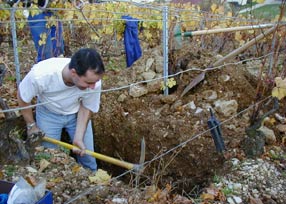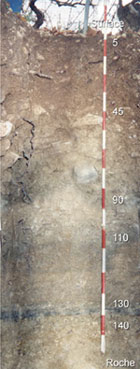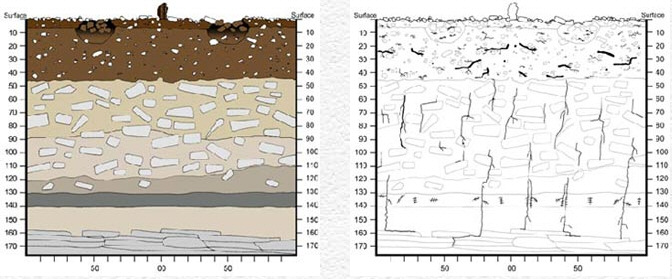


Soils are alive
Our soils are alive : the proof...
Last autumn; we conducted with the Group of Studying and Managing the Terroirs (Gest in French) a profile study of a section of soil in the Côte de Lechet. Whilst further improving our knowledge of our soils, we have also visualized the arrangement of the root system and measured the impact of tractors. With this work we could also evaluate the effect of ploughing and so adapt more precisely its depth.
Lorenzo Maini (from the Gest) and Didier Defaix dug a rectangular pit, perpendicular to the rows in order to visualize the horizons of the soil under the row and between the rows. The section reached a depth of almost 2 meters.
The studied section of soil shows a succession of very different horizons:
- At the surface, the aspect is porous
- From 0 to 45 cm , there is a brown calcareous soil. This horizon is the result of the accumulation of eroded elements from the top of the slope during the last glaciations.
We can distinguish: * 0-5 (ploughing): this horizon is organised with small, round aggregates. The activity of earthworms takes part in the very good porosity of this horizon. * 5-45 (deep ploughing before plantation): the structure is composed of angular aggregates of bigger size with reduced porosity.
- In the deep part (45 to 160 cm ) , the horizons are the result of the erosion both of the slope and of the underlying rock. From 45 to 110 cm , the blocks of compact limestone, sometimes quite big, are the result of mechanical weathering of the rock. The porosity is important. From 110 to 130 cm , the layer is composed by ochre silt and pieces of fossils. The porosity is maintained by the presence of micro-fissures and of some rare blocks of limestone. Between 130 and 140 cm , there is a thin layer of black clay, barely permeable on the surface upon which the water slides. From 140 to 160 cm: accumulation of clays, silts and stones with a rounded form, a result of the alteration of the underlying rock. The porosity is good.
-Then we reach the rock composed of weathering limestone, releasing constituent elements.
he cultural profile (left) provides information about the effect of the work realised by man.
The root profile (right) shows the arrangement of the roots.
The 2 profiles above provide a lot of valuable information. In the first few centimetres (0-5), we see that the porosity of the soil and its aeration are excellent thanks to ploughing, to the activity of the soil's fauna and to the small roots of weeds (remember that we let the weeds remain for a part of the year in accordance with the technique of natural and controlled weeding -Enherbement Naturel Maîtrisé in French). Where the tractors run, the packing down of the soil is still significant despite using light tractors with low pressure wheels. However, using coulters has fragmented and aerated the more compact zone.
The observation of the root system shows that all the horizons of the soil are explored and exploited by a big quantity of small roots. So the plant has an important potential at its disposal, able to access water and minerals throughout the vegetal cycle. This had been checked during summer 2003 because the vine did not suffer from the dryness which was most severe.
All the observations realised thanks to this study show the importance of the work we have been doing for the last few years to improve the aeration and thus the vitality of our soils. This occurs notably through ploughing and through the use of compost. The interest of compost is that it "feeds" the soil and then the soil feeds the plant (in this system, the plant does not intake the fertilizer directly).
We still have to improve the porosity of the horizon 5-45 through ploughing and supplying organic matter such as guano in order to stimulate the activity of the soil's micro-organisms.
We have learnt a lot from this study and also from the soil analysis we regularly conduct. Better knowledge of our soils allows us to understand even better the characteristic of each wine and the very different styles of our appellations.
DOMAINE BERNARD DEFAIX
17, rue du Château, Milly - 89800 Chablis
Tél. 03 86 42 40 75


